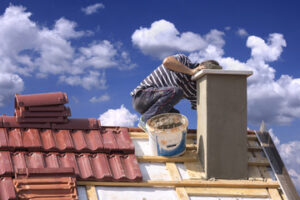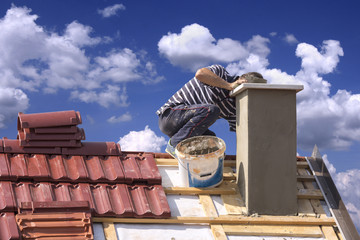Cracks in your chimney can cause serious damage to your home. Charleston Chimney Repair can fix these problems before they get worse. Chimney crowns crack over time, and the resulting gap allows moisture to seep into bricks and your flue lining. Having this area repaired prevents water leaks.
 Brick spalling is one of the earliest signs that your chimney structure needs repair. It can also be a very expensive issue to ignore. It exposes the porous nature of masonry and allows moisture to penetrate the underlying material. This can quickly lead to deterioration of the masonry and other materials like drywall, boards, and framework that support the chimney structure.
Brick spalling is one of the earliest signs that your chimney structure needs repair. It can also be a very expensive issue to ignore. It exposes the porous nature of masonry and allows moisture to penetrate the underlying material. This can quickly lead to deterioration of the masonry and other materials like drywall, boards, and framework that support the chimney structure.
It can also cause a domino effect where other weak areas of the chimney are affected. Loose or crumbling bricks can fall off the chimney and land in the fireplace, causing further damage and creating a fire hazard. Chimneys are designed to handle a large amount of heat, but over time even a well-built chimney can suffer from structural damage due to moisture ingression.
Many things can cause moisture penetration, but the main causes of spalling are faulty construction or building practices, poor weather and improper maintenance. Water can seep into a chimney through a damaged flue liner or crown and enter the chimney through a crack in the chimney’s lining or through the roof and attic. Having the wrong type of mortar for a chimney can also cause spalling. Mortar that is too hard can crush bricks or crumble and separate from the masonry over time, so it’s important to use the right mortar for your chimney.
A qualified chimney sweep will be able to recommend the best course of action for your home at the first sign of spalling bricks. This may involve a waterproof coating or repairing the underlying problem that is causing the brick to absorb water and deteriorate.
While some homeowners might be tempted to attempt this type of chimney repair on their own, it’s always best to leave this sort of work to the professionals. Working on a chimney can be dangerous and requires specialized tools to complete the task safely. Chimney sweeps can check for spalling bricks and many other common chimney issues during an annual inspection and cleaning. Constant maintenance and regular chimney cleanings will help to prevent spalling bricks in the future by catching them early on and taking care of any other repairs as they occur.
Leaning Chimney
A leaning chimney is a serious problem that needs to be addressed as soon as possible. It places stress on the surrounding building structures and can even cause a chimney or fireplace to collapse, potentially injuring you or putting your family at risk of fire or carbon monoxide poisoning. A chimney that is separating from the house may also lead to pest infestation and water damage.
Chimneys typically tilt due to a foundation issue. Heavy rains, flooding, and other environmental factors can cause soil to move and shift around a home’s foundation, causing it to sink and lose its structural integrity. A settling foundation is the most common reason for a chimney to start leaning, but it’s not the only reason.
The concrete footing (also called a chimney pad) that supports the thousands of pounds of brick resting above it is critical to the stability of your chimney. If the footing isn’t built with high-quality concrete or reinforced with rebar, it can crack and deteriorate over time. Once this happens, the weight of your chimney can shift and exacerbate the tilting.
If you notice that your chimney is leaning, you’ll likely need to hire a professional for a full foundation repair. This can help ensure that no more serious issues could affect the chimney and your home, and it will make sure that any repairs are done correctly to avoid future problems.
It’s important to note that while a leaning chimney is a clear sign of serious damage, it doesn’t mean that the foundation has failed or that your entire home is at risk of collapsing. A reputable foundation repair business should be able to assess the entire foundation and identify any additional problems that need to be repaired.
Crumbling Chimney
Even a well-constructed brick chimney will start to show signs of wear and tear over time. When these problems are caught early on, they can be fixed for a much lower cost than a complete chimney rebuild. Often, a procedure called “tuckpointing” can repair deteriorating mortar and restore the structural soundness of your chimney. This process involves scraping away old mortar and replacing it with new mortar. It also addresses any cracks that may be present in the masonry.
One of the biggest signs that your chimney needs repairs is if the bricks themselves are crumbling. This is a serious problem that should not be ignored. The mortar that holds the bricks together serves a vital support role, and when it starts to crumble, the entire structure is at risk of falling apart.
In addition to being a hazard for anyone who is close by, a crumbling chimney can cause major damage to your home. Chimneys that aren’t properly repaired can let rain and melting snow enter, and this moisture can erode the masonry and lead to severe water damage throughout the house. This moisture can also freeze and expand as it cycles through freezing and thawing temperatures, further damaging the bricks and mortar.
Besides water damage, a crumbling chimney is an additional fire hazard. The flammable creosote that accumulates on the walls of the chimney can easily ignite if it comes into contact with a spark. Cracks and crumbling bricks make it more difficult for the fire to burn hot enough to disperse this flammable material safely.
Another sign that your chimney is in need of repair is the appearance of peeling or discolored wallpaper near the fireplace. This can indicate that the chimney has a leak and water is seeping from the flue into the walls of your home. If you notice this, it’s important to call for chimney repair as soon as possible.
It is recommended that homeowners have their chimneys professionally inspected regularly by a certified chimney sweep to ensure they are safe for use. Even a well-constructed chimney will eventually need to be rebuilt, and a professional will be able to assess your chimney’s condition to determine the best course of action for repair.
Water Damage
While chimneys are durable structures built to withstand the elements, wind, fire, ice and rain can take their toll. Chimneys are particularly vulnerable to water damage, and ignoring the signs of moisture problems can lead to costly chimney repairs. Fortunately, annual inspections can help spot problems early so they can be addressed before excessive deterioration takes place.
Whether you’re looking for signs of a leak or damage to your home or chimney, there are many common indicators that it’s time to call in the experts. Some of the most common include water stains around the fireplace and the chimney hearth and the appearance of a white powdery substance known as efflorescence in and near the chimney stack. If you notice any of these signs, a leaky chimney is likely to be the cause.
The chimney crown, cap, flashing, and masonry are all susceptible to moisture damage. Chimney caps and crowns are easy to repair, but if the flashing or masonry are damaged, it’s a good idea to have them replaced. Chimney flashing is a metal sheet that covers the top of the chimney. It protects the chimney from rainwater and snow and helps prevent moisture from entering the chimney through the roof. If the flashing becomes corroded or rusty, it will need to be repaired. The best way to fix this problem is to replace the entire chimney flashing. However, this is a dangerous job that should be left to professionals.
Bricks and mortar are highly porous and will absorb water over time. Eventually, this moisture will cause a variety of problems, including cracks, crumbling, and even structural failure. This type of masonry damage can be difficult to detect and requires an experienced technician to identify and repair it.
Waterproofing is a great way to reduce the need for frequent chimney repairs. A waterproofing sealant is a brick-based product that can be applied to the exterior of the chimney to create a protective barrier against water. This product will not only help to keep the chimney sturdier, but it can also extend the lifespan of your fireplace and chimney by helping it stay strong and dry for longer.
